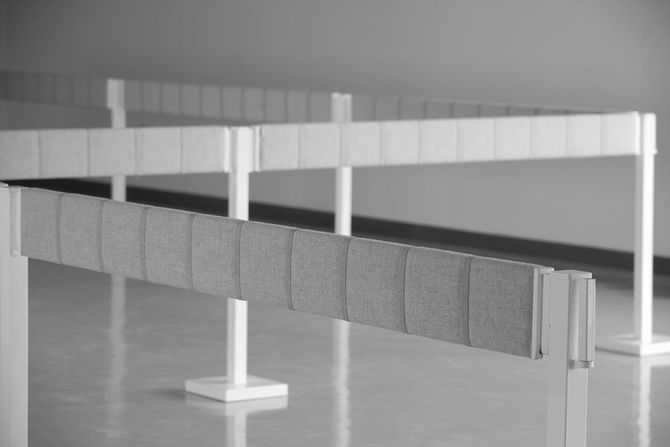
Barrier, ref: 9774-14
Barrier, ref: 9774-14, is a series of 10 modular sculptural components, 5 of which I was invited to (re)configure as part of the international Art_Textiles exhibition at The Whitworth Gallery, Manchester (10.10.15 - 31.1.16. ). This work is part of a larger body of studio enquiry that explores the poetics and politics of space through sculptural installations.
10/9/15
Whitworth Art Gallery, Manchester, United Kingdom
The modular sculptural components take the form of temporary ‘barriers’, which play between a work of art and functional object. Consciously referencing seminal hard-edged minimalist modular-configurations such as Donald Judd’s floor-based open frame-like structures, these works are upholstered and intricately embroidered through the labour intensive process of darning. Rather than take centre-stage like their minimalist counterparts, they might easily be mistaken for institutional furniture, where the self-effacing labour intensity of their production would go unnoticed.
The research employs a feminist/poststructuralist methodology exploring the marginalisation of textiles, invisible labour and women artists’ historical access to museums and galleries. As modular units, the barriers have the potential to physically define space, delineate and divide, afford significance, dictate movement and alternately either deny or allow access. Articulating space in a physical way, the work aims to interrogate the politics of space and the broader metaphorical connotations of borders and boundaries and their implications in terms of traditional discourses of power. Whilst the modular components afford significance to the space that they delineate, the boundary that they define is clearly contingent and provisional. In drawing attention to their temporary and arbitrary nature, the work prompts us to think about the way that boundaries are not neutral but socially and historically constructed and as such are open to critique and revision.
Within the Whitworth, the space articulated by the upholstered barriers was left empty (suggesting the absence of Textile Art within the art historical canon) save for a hand-embroidered ‘duster’ and ‘dust sheet’ by the artist Susan Collis which similarly involve an enormous amount of hidden labour and play with our perceptions of everyday objects.
Within Towneley Hall, the upholstered barriers were seemingly ‘invisible’ as they protected Zoffany’s ‘important’ work and the eminent subject of his painting the influential art collector Charles Townley.






